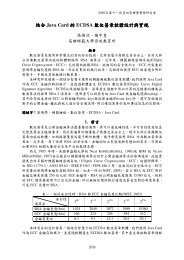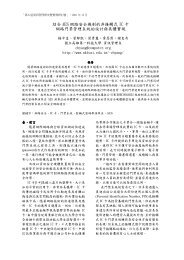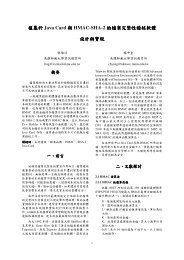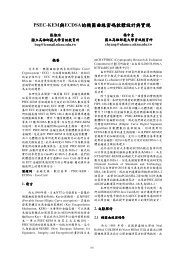aryabhata remainder theorem: relevance to public-key crypto ...
aryabhata remainder theorem: relevance to public-key crypto ...
aryabhata remainder theorem: relevance to public-key crypto ...
You also want an ePaper? Increase the reach of your titles
YUMPU automatically turns print PDFs into web optimized ePapers that Google loves.
14 RAO AND YANG<br />
Example 9. 17x + 1 = 4y.<br />
By using kuttaka and the IAA, we obtain S1 = 4, S2 = 1, and n = 1. As one<br />
solution we have 17(−1)+1 = 4(−4). Taking the respective moduli, we have −1<br />
mod 4 = 3 and −4 mod 17 = 13, giving us the optimal solution 17·3+1 = 4·13.<br />
Example 10. 7x + 1 = 4y.<br />
By using kuttaka and the IAA, we obtain S1 = 2, S2 = 1, and n = 2. As one<br />
solution we have 7(1) + 1 = 4(2). Here both values for x = 1 and y = 2 are<br />
optimal.<br />
For a more general case, let us make c = 11 in the above example.<br />
Example 11. 7x + 11 = 4y.<br />
Multiplying the previous solution by 11, we get 7·11+11 = 4·(2·11). To obtain<br />
an optimal solution, we may apply the modular reduction 11 mod 4 = 3 and 22<br />
mod 7 = 1. Then we get 7 · 3 + 11 = 4 · 1, clearly a false solution. The correct<br />
way <strong>to</strong> get an optimal solution is <strong>to</strong> subtract (or add) a suitable multiple of a · b<br />
<strong>to</strong> both sides of the equation <strong>to</strong> obtain an optimal value for either x or y. Ifwe<br />
subtract 2ab from both sides, then we have 7 · (11 − 2 · 4) + 11 = 4 · (22 − 2 · 7),<br />
yielding 7 · 3 + 11 = 4 · 8, a correct solution. Here the solution is optimal, as<br />
x = 3 is optimal. Note that, in this case, y = 8 is not optimal but the solution is<br />
optimal by Definition 1.<br />
Proof of Theorem 1. As an easy extension <strong>to</strong> the general case a · x + c = b · y<br />
(for c, a multiple of d), we have a solution x ′ = (−1) n · S2(c/d) and y ′ =<br />
(−1) n · S1(c/d). Here x ′ and y ′ may not be optimal. To obtain an optimal solution,<br />
we consider adding kb <strong>to</strong> x ′ and ka <strong>to</strong> y ′ such that at least one of them becomes<br />
optimal. For that we first take modular reduction x = x ′ mod b. Then x = x ′ + kb<br />
for some k. To balance the equation we take y = y ′ + ka. This proves Theorem 1.<br />
Theorem 1. An optimal solution <strong>to</strong> a · x + c = b · y is given by:<br />
x =[(−1) n · S2(c/d)] mod b,<br />
y = (−1) n · S1(c/d) + ka, where k ={x −[(−1) n · S2(c/d)]}/b.<br />
References<br />
[1] E. R. Berlekamp, Algebraic Coding Theory, McGraw-Hill, New York, 1968.<br />
[2] W. E. Clark, The Aryahbatiya of Aryabhata, University of Chicago Press, Chicago, 1930.<br />
[3] H. Garner, The residue number system, IRE Trans. Electronic Computers, vol. EC-8, pp. 140–<br />
147, 1959.<br />
[4] C. F. Gauss, Disquisitiones Arithmeticae, 1801. English translation by Arthur A. Clarke,<br />
Springer-Verlag, New York, 1986.<br />
[5] H. Handschuh and P. Paillier, Smart Card Cryp<strong>to</strong>-Coprocessors for Public-Key Cryp<strong>to</strong>graphy,<br />
Cryp<strong>to</strong>Bytes, vol. 4, No. 1, pp. 6–11, 1998.<br />
[6] S. Kak, Computational aspects of the Aryabhata algorithm, Indian J. His<strong>to</strong>ry Science, vol. 21,<br />
No. 1, pp. 62–71, 1986.
















